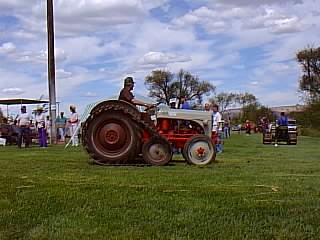OK guys, I'll try some more. Is this a conspiracy, everybody really gets it but wants me to struggle to try to explain it in different ways? O R am I diging myself into a hole, deeper with each abortive attempt. I really don't care if someone proves I'm wrong but I require proof, not vague conjecture based on gut feel or whatever. It gets a lot harder when you get rigorous, beyond the "I think there are 12437 angles on the head of the pin", but no one actually counts them.
Tracks laying on the ground are a red herring and shouldn't properly enter into the investigation. The radius, diameter, or circumfrence of the wheel inside the tracks matters.
I think before launching another couple thousand words I will request someone, anyone to point out the specific error(s) in my previous analysis. Please be a little more specific than, uh, I think its wrong (that might be mistaken for I don't understand it).
A couple small issues:
You said: as the wheel only runs on the bottom track the diameter would not include the top track
What matters here is not sophistry but engineering and math. If the half diameter (read radius) includes track thickness that is good enough.
A N D
... if i put a track from back
wheels to front(even tho they are diffrent sizes)both wheels will cover the same
distenice(SP)one may do 100 turns and the other 187 turns (or what ever depending on...
YES! one may turn 100 times the other 187 but when the tracks are LOCKED to the wheels by whatever means, friction, gears, pixie dust..
the wheels must each be driven at the correct ratio or the track must expand or contract A L O T if all wheels are driving (none idling) as with 4wd. If you are assuming 2wd then we have no further discussion.
A N D
...where the belt runs (bottom eage of "V")will travel the same distenice even if the gearing is 4to 1
YES!! A N D if you drive both pulleys from the same motor via a transmission, the transmission must drive each wheel at the correct ratio or there will be massive binding and or slipage. Imagine this with an extremely thick belt running on the ground. Each revolution of the belt around the wheels, propels it a belt circumference (outer perimeter where the rubber meets the road) distance ahead. Keep same pulley wheels but put on even thicker belt. Now the perimeter is greater. One rev of belt propels the beast farther than before. Do you agree so far? If yes, we done it!
I didn't change the pulleys just the belt thickness and it went farther with a thicker belt. But how can that be? It is because that is the way it works, not the lay the belt on the ground diversion.
Need more easy to visualize explanation? The belt laying on the ground and being driven over has no difference inside to outside. When wrapped around a wheel the inner surface travels the same distance as where it contacts the wheel (pulley) B U T the outer surface of the belt (track) travels farther as it is farther from the center of rotation (by the belt/track thickness. Think what would happen if you had a 1 inch wheel and an 11 1/2 inch thick track and could get it to function(this is a thought experiment, we ain't buildin' it so binding and flex isn't gonna stop us).
Each rev of the wheel without track would move axle forward 3.14 times 1 inch = 3.14 inches
B U T with the track on, one rev would move the axle forward 3.14 times times 24 inches = 75.36 inches
Having the track wrapped around the wheel increases its effective daimer by twice the thickness of the track. This is like putting taller tires on your car, it goes farther with each rev of the wheel. Imagine that yoiu have car tires with really really thick tread. Measure how far it goes down the road when the wheel turns one time. Now take a sharp knife and peel the tire. Do it neatly so you remove 20% of itsdiameter in one thick strip. Set that removed strip asside for later. Now rotate the tire one rev and notice that it goes a lot less distance down the road in one revolution. Now lay out the piece yoiu peeled off. Run over it with the peeled tire. Oh wow man, if doesn't effect the distance we go down the road does it. Runing on the pavement or a piece of removed tire makes no difference.
B U T when the ruber was on the tire it went further J U S T L I K E I T W A S A C A T T R E A D.
I think you probably got it now but if you are unconvinced, point out my error(s) in detail, with precision, so that I may determine the actual point of departure in our separate understandings. I would be just as happy to be proved wrong as to get your light bulb to come on. I enjoy the communications challenge (well it frustrates me some too 'cause I spell so poorly, type so slow, and the turn around on messages is so slow its tough for me to remember exactly the board position (chess) so to speak.
Thanks for hanging it there with me, we'll converge soon I think.
Patrick



